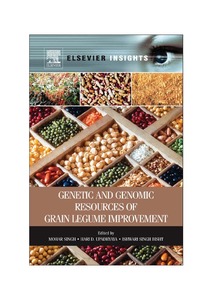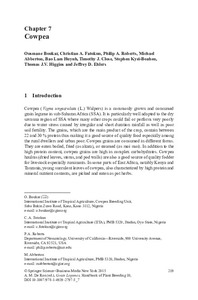| dc.contributor.author | Boukar, O. |
| dc.contributor.author | Fatokun, C.A. |
| dc.contributor.author | Roberts, P.A. |
| dc.contributor.author | Abberton, M.T. |
| dc.contributor.author | Huynh, B.L. |
| dc.contributor.author | Close, T.J. |
| dc.contributor.author | Kyei-Boahen, S. |
| dc.contributor.author | Higgins, T.J.V. |
| dc.contributor.author | Ehlers, J.D. |
| dc.date.accessioned | 2019-12-04T11:10:22Z |
| dc.date.available | 2019-12-04T11:10:22Z |
| dc.date.issued | 2015 |
| dc.identifier.citation | Boukar, O., Fatokun, C.A., Roberts, P.A., Abberton, M., Huynh, B.L., Close, T.J., ... & Ehlers, J.D. (2015). Cowpea. In A.M. De Ron, Grain legumes: handbook of plant breeding (p. 219-250). New York: Springer |
| dc.identifier.isbn | 978-1-4939-2796-8 |
| dc.identifier.uri | https://hdl.handle.net/20.500.12478/2108 |
| dc.description.abstract | Cowpea, Vigna unguiculata, is an important grain legume adapted to the sub-Saharan Africa (SSA) where it contributes to the nutrition, health, and income of rural and suburban inhabitants. It is indigenous to SSA with both cultivated and wild relatives distributed across the whole subregion. The International Institute of Tropical Agriculture (IITA) holds a collection of more than 15,000 accessions from 90 countries. This valuable source of traits is being exploited to address preferences of consumers and producers as well as the numerous cowpea production constraints. Substantial progress has been achieved through the development of cultivars targeting these biotic and abiotic stress factors. Current cowpea breeding programs aim at enhancing yield and grain quality, largely through introgression of desirable genes. With the recent development of genomic tools and the successful establishment of genetic transformation in cowpea, modern breeding approaches integrating new biotechnologies and conventional breeding methods are being implemented in several of the existing breeding programs. Ongoing activities will also ensure a sustainable production of quality seeds of released varieties in response to the increasing demand for the crop in SSA. |
| dc.format.extent | 219-250 |
| dc.language.iso | en |
| dc.publisher | Springer |
| dc.subject | Cowpeas |
| dc.subject | Vigna Unguiculata |
| dc.subject | Grain Legumes |
| dc.title | Cowpea |
| dc.type | Book Chapter |
| dc.description.version | Peer Review |
| cg.contributor.crp | Grain Legumes |
| cg.contributor.affiliation | International Institute of Tropical Agriculture |
| cg.contributor.affiliation | University of California |
| cg.contributor.affiliation | Commonwealth Scientific and Industrial Research Organisation, Australia |
| cg.contributor.affiliation | Bill & Melinda Gates Foundation |
| cg.coverage.region | Africa |
| cg.coverage.region | West Africa |
| cg.coverage.country | Nigeria |
| cg.authorship.types | CGIAR and advanced research institute |
| cg.iitasubject | Cowpea |
| cg.howpublished | Formally Published |
| cg.accessibilitystatus | Limited Access |
| local.dspaceid | 90637 |
| cg.identifier.doi | http://dx.doi.org/10.1007/978-1-4939-2797-5_7 |


